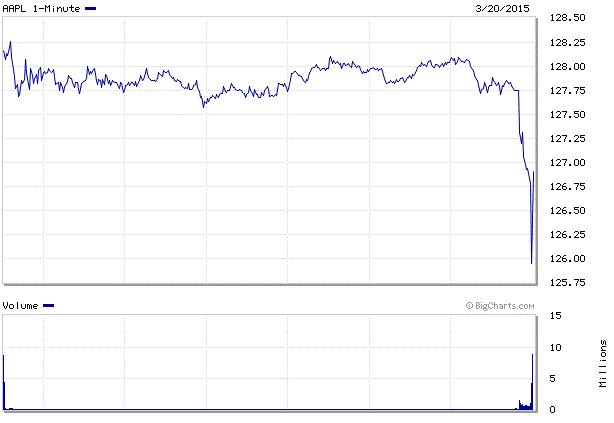What the heck happened to AAPL in the last few minutes of trading on Friday?
If you were watching AAPL at the close on Friday, March 20, 2015, you would have noticed that there was a neck-breaking snap in direction. The stock was
chugging along sideways and then, at exactly 10 minutes before the close, it made a wild move to the downside. It dropped over 2%, from $127.74 to a low of
$125.15 in a few minutes. It then rebounded to close at $125.90. The move was on very high volume, with the last 10 minutes of trading accounting for
nearly 20% of the day’s total volume.

So, what exactly was the explanation for this move? It was driven by the options market.
This phenomenon is not uncommon to see on expiration Friday. Friday was a big expiration for the market. It was Triple Witching – where options, stock
index futures, and stock index options expire – and it was the end of a quarter. It was significant for AAPL for a couple of reasons.
End of a quarter. AAPL has multiple expiration series available. There are weekly, monthlys, quarterlys, and LEAPS. However, those shorter term series are
not available until they get closer to expiration. For example, AAPL has weekly options for March, April, and the first week of May. Those weekly options
in May and June, will become available as we get closer to those expirations. The same is true for monthly options. May, June, and July are available. But
the August monthly will not become available for another month. If an options trader wanted to do a trade out beyond that, they are left with the choice of
quarterlys or LEAPS.
So, back six months ago or so, options traders had the March expiration series available, but no February or April. The result is that the March expiration
series, like most quarterly options, tends to attract a lot of options volume. We see this in the Open Interest, which tells us how many contracts existed
at the market open on that day. Friday morning there were 1,297,424 open contracts on AAPL in the March 20, 2015 expiration.
That is a boatload of options that are either going to expire worthless or be in the money. Each of those options represent 100 shares. Some quick math
estimates that there is nearly $16B that needs to be resolved on that last day of trading. That’s a lot of semoleons.
The second factor affecting those AAPL options is that March 2015 options were available before the 6:1 split. That split results in options strikes
getting cut in sixths, too. It results in some pretty strange options strikes. A lot of traders would prefer to stick to the strikes that are easily
divisible by six, thus giving nice round numbers 120, 125, or 130, as opposed to 121.42, 122.86, 124.29, etc. This resulted in a lot of options open
interest around those round numbers.
Finally, what really drove options pricing in the close was a phenomenon called Maximum Pain. Market Makers and Specialist are sometimes made out to be
evil-doers, scheming to fleece retail traders. While their intention is to make money, they are not malevolent. Their job is to make a market so traders
can trade. They get a fair compensation by being able to trade on the opposite side of you. They buy at the “bid” – the lower price – and they sell at the
“ask” – the higher price. The bid/ask spread is their profit.
They may hold hundreds, thousands, or even hundreds of thousands of options – both short and long, puts and calls. The result is a big portfolio. Since
they do not strive to take a market direction, they will balance their portfolio so that it is delta neutral (that is optionspeak for a trade that makes
money when the stock is directionless.) Their goal is to have their portfolio delta neutral at expiration.
As the stock went into the close on Friday, that was not the case for them. Ostensibly, most market makers had portfolios that were delta positive. So, 10
minutes before the close, they place trades to get them to a delta neutral position. While trading options will change a portfolio’s delta, the easiest way
to get delta in or out of a portfolio is to buy or sell stock.
Most of that trading is programmatic. The once full pits in the CBOE are now replaced by robots. “Danger, Will Robinson! Danger!” So, while this is not a
new phenomenon, it has changed the market behavior. Instead of taking place over the course of a day, it can happen very rapidly at the market close.

This wild move was not a nefarious conspiracy to manipulate the market. It was just the market makers doing what they needed to do to control their risk.
The result is that it can drive a stock to a specific strike where the market makers receive the least pain. Unfortunately, that is the point of maximum
pain for options traders.
Eric Hale
OptionsANIMAL Instructor


